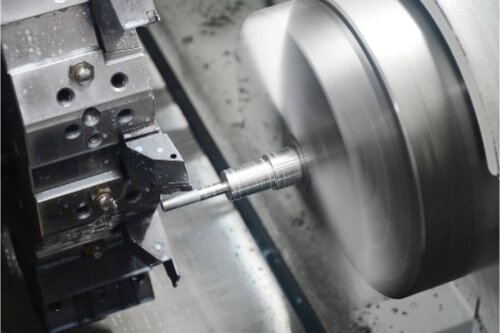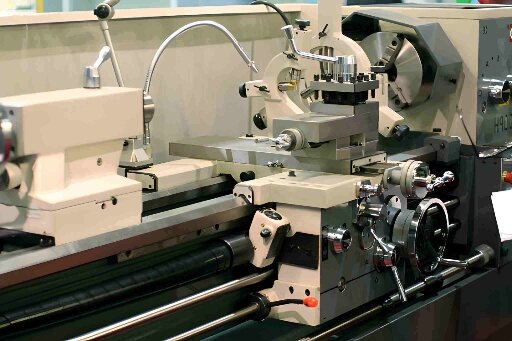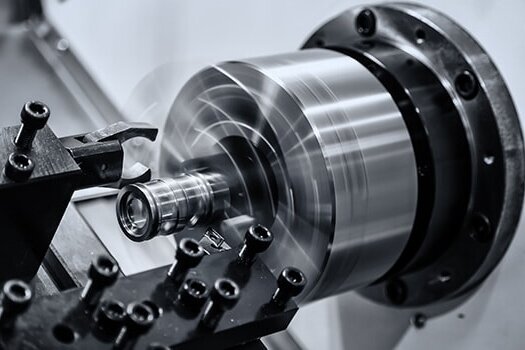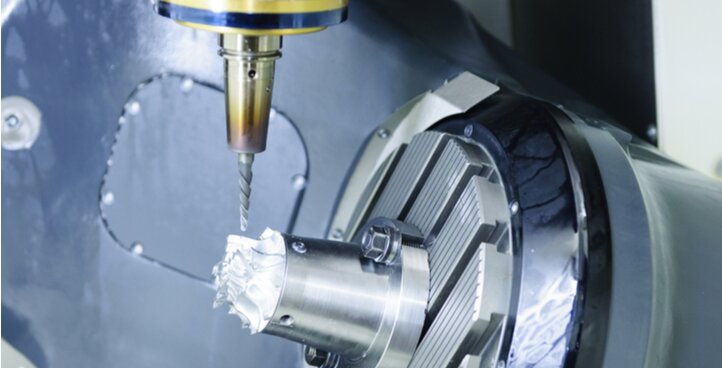Manufacturers often deal with challenges when making round or cylindrical parts that require tight tolerances and smooth finishes. Parts like shafts, pins, and threaded components must fit accurately, turn smoothly, and work reliably under load. Even small design or machining mistakes can cause imbalance, vibration, or early wear during use.
Turning with a lathe is an efficient way to achieve precision and repeatability. In this process, the machine rotates the material around a central axis while a cutting tool shapes it. This method allows for accurate diameters and smooth surfaces in one continuous operation.
This article explains how lathes function, the operations they can perform, and why they are ideal for parts with cylindrical features. Let’s see how this process shapes reliable parts for different manufacturing needs.

What Is a Lathe Machine?
선반은 고정된 절삭 공구가 재료를 제거하는 동안 공작물을 회전시켜 재료를 성형하는 기계입니다. 주요 목표는 중심 축을 중심으로 매끄럽고 균일하며 완벽하게 둥근 모양을 만드는 것입니다. 이 공정은 샤프트, 튜브, 부싱과 같은 부품을 고정밀로 제작하는 데 이상적입니다.
When the workpiece rotates, the cutting tool moves along its length or across its diameter. The speed, feed rate, and tool position are adjusted according to the material and desired result. Together, these settings control the part’s final size and surface finish.
Types of Lathes Used in Modern Manufacturing
Different types of lathes fit different production needs. Each type offers its own advantages depending on the required accuracy, complexity, and production volume.
- Manual Lathe: Used mainly in small workshops and for prototypes. Operators control the cutting depth, speed, and feed rate by hand. It’s a great choice for one-off parts or short production runs where flexibility is key.
- 터렛 선반: Equipped with a rotating turret that holds several tools at once. This setup allows quick tool changes and saves time between operations. It’s well-suited for medium-scale production that requires repeated machining steps.
- CNC 선반: Controlled by computer programs, CNC lathes can perform complex cuts automatically and with great consistency. Engineers can set exact tool paths and speeds to achieve repeatable, accurate results. They are widely used in industries such as aerospace, medical, and automotive manufacturing.
- Automatic (Swiss-Type) Lathe: Designed for producing large quantities of small, detailed parts. It can perform multiple operations at the same time, maintaining excellent precision. This type is ideal for thin, long, or intricate components that require fine detail and accuracy.
Key Components of a Lathe
A lathe works through several main components that function together to achieve precise cuts.
- 축: The rotating axis that holds and turns the workpiece. It provides the power that drives the entire cutting process.
- 척: The device that grips and centers the material. It keeps the workpiece stable and secure while the machine operates.
- Carriage: The moving part that carries the cutting tool along the surface of the workpiece. It controls how fast and in which direction the tool moves.
- Tool Post: Mounted on the carriage, it holds the cutting tools and allows quick changes or angle adjustments for different cuts.
- Tailstock: Positioned at the opposite end of the spindle, it supports long or slender workpieces. It can also hold tools such as drills or reamers for extra machining steps.

Why Turning Is Ideal for Cylindrical Features?
Turning is the go-to method for producing parts that rotate around a central axis. It delivers high precision, smooth finishes, and consistent dimensions—key qualities for components that require perfect symmetry.
Rotational Symmetry and Material Removal
Turning works best for circular or cylindrical parts because the workpiece spins while a stationary cutting tool removes material. This motion allows the tool to contact the surface evenly, shaving off thin layers in a controlled way.
It’s an efficient process for making shafts, rods, bushings, and threaded parts. Turning keeps the part perfectly concentric, meaning every feature shares the same center axis. This is essential for mechanical balance and smooth operation. It also reduces material waste since the tool removes only what’s necessary to reach the final dimensions.
Achieving Tight Tolerances
Lathes are known for their ability to hold precise diameters and create fine surface finishes. By adjusting spindle speed, feed rate, and tool position, operators can reach tolerances within a few microns. The steady rotation ensures that each tool pass cuts the material evenly.
This level of control is crucial for parts like bearings, couplings, and pistons, where even small errors can impact performance. CNC lathes take this further by automating movements with digital precision. They remove the chance of human error, producing smooth, accurate parts that meet strict engineering standards.
High Repeatability for Batch Production
CNC lathes offer excellent repeatability for large production runs. Once programmed, they follow the same motion path for every workpiece, ensuring each part matches the same specifications.
This consistency saves time during inspection and reduces the risk of defects. Automated tool changers and monitoring systems help maintain performance by detecting tool wear early. For manufacturers, this means faster production, fewer interruptions, and reliable quality across every batch.
Types of Lathe Operations
Turning is a versatile process that supports several machining operations. Each one shapes the workpiece in a specific way to reach the desired size, form, and surface quality.
Facing and Straight Turning
Facing creates a smooth, flat surface at the end of the workpiece. The cutting tool moves from the outer edge toward the center while the part rotates. This prepares the surface for later steps like drilling, threading, or assembly. It also ensures the end of the part is square and even.
Straight turning reduces the diameter of the workpiece along its length. The tool travels parallel to the rotation axis, removing layers evenly to form a smooth and uniform cylinder. This operation defines the main body of the part and provides a reference dimension for further machining.
테이퍼 터닝 및 윤곽 터닝
Taper turning forms a gradual change in diameter along the length of the part. This can be done by adjusting the tool angle or offsetting the tailstock. It’s commonly used for making shafts, cones, and connectors that need a smooth transition between different diameters.
Contour turning shapes, curved or irregular profiles, instead of straight lines. CNC lathes handle this task best since they follow programmed tool paths with precision. This operation is often used for parts with decorative or functional shapes, such as knobs, handles, or precision fittings.
Grooving, Threading, and Parting Off
그루빙 cuts narrow channels on the surface of the workpiece. These grooves can act as seats for O-rings, retaining clips, or snap rings used in mechanical assemblies.
Threading forms helical grooves along the outer or inner surface to create screw threads. The process depends on the exact timing between spindle rotation and tool movement. CNC control makes this operation precise and consistent across batches.
Parting off, also known as a cutoff, separates a finished section from the remaining material. A thin cutting tool moves straight into the rotating workpiece until the part detaches. It’s usually the last step of the process, leaving a clean edge ready for assembly or further finishing.

CNC Lathe Technology in Modern Production
Modern manufacturing depends on CNC lathe technology for precision, speed, and consistent quality. These machines blend digital control with mechanical accuracy to create complex parts efficiently and reliably.
Integration of CAD/CAM Systems
CNC lathes connect directly with CAD and CAM systems. Engineers design the part on a computer and convert it into machine-readable code. This process removes manual setup mistakes and ensures the tool path matches the design exactly.
When design updates are needed, engineers can easily adjust settings like feed rate, tool position, or cutting depth in the software. This digital workflow shortens setup time, improves accuracy, and reduces total lead time. It’s especially helpful for prototypes and custom jobs that often need quick revisions.
Multi-Axis Machining and Live Tooling
Advanced CNC lathes now feature multi-axis movement, allowing the cutting tool to move in several directions beyond the standard X and Z axes. This makes it possible to create complex shapes—such as curves, angles, and undercuts—without removing and repositioning the part.
Live tooling increases flexibility even further. It allows the lathe to perform additional operations like drilling, milling, or tapping while the workpiece stays fixed in place. This reduces setup changes, improves alignment, and saves time.
Automation and Smart Manufacturing
Automation has transformed CNC lathes into intelligent, self-operating systems. Robots can load and unload materials automatically, keeping machines running with little operator involvement. This setup supports continuous production and consistent results, especially for large-scale orders.
Tool monitoring systems detect wear and adjust cutting conditions automatically to maintain accuracy. Digital sensors send performance data to operators, allowing predictive maintenance before problems occur. These technologies build the foundation for smart manufacturing.
Design Considerations for Lathe-Turned Parts
Designing parts for turning requires thoughtful planning. Even small design choices can influence cost, precision, and ease of manufacturing.
Selecting Suitable Geometries
Lathe turning is most effective for round and symmetrical shapes. Keep the design simple and centered along the rotation axis. Smooth transitions between diameters help reduce tool stress and improve stability during cutting.
Adding fillets or rounded edges lowers stress on the material and produces a cleaner finish. Threads, grooves, and holes should follow standard dimensions so that standard tools can be used. Avoid thin walls or deep cuts that might cause vibration or deformation.
Setting Realistic Tolerances
Tight tolerances improve precision but also increase machining time and cost. Extremely accurate parts require slower speeds and more inspection steps. Designers should choose tolerance levels that meet the part’s function without making production overly complex.
For example, critical fits—such as between shafts and bearings—may require micrometer-level precision. However, non-contact surfaces can have looser limits. Discussing tolerance requirements with machinists early helps strike the right balance between performance and cost. This approach avoids unnecessary rework and keeps production practical.
Material and Tool Compatibility
The choice of material affects both machining performance and tool life. Hard metals like stainless steel and titanium need strong, wear-resistant cutting tools, often coated with carbide or ceramic. Softer materials such as aluminum or brass allow faster machining but may need sharper tools to prevent surface marks or tearing.
Heat generation is another key factor. Some materials produce high cutting temperatures, which can cause tool wear or minor dimensional shifts. Using the correct tool shape, coolant, and cutting speed helps control heat and maintain consistency.
자주 묻는 질문
What types of parts are best suited for lathe machining?
Lathe machining is best for parts with rotational symmetry. Typical examples include shafts, rods, bushings, spacers, pulleys, and threaded parts. Any component that rotates around a central axis can be efficiently made on a lathe.
Can complex shapes be made using CNC turning?
Yes. CNC lathes with multi-axis control and live tooling can produce detailed and complex shapes such as tapers, contours, grooves, and threads. With precise digital programming, CNC turning combines several processes—like drilling, milling, and slotting—into one setup.
What tolerance levels can be achieved in lathe machining?
Modern CNC lathes can reach tolerances as tight as ±0.005 mm (±0.0002 in) for high-precision components. The actual tolerance depends on the machine’s condition, material type, and tooling setup. Manual lathes typically hold slightly wider tolerances, around ±0.02 mm (±0.001 in).
How does surface finish differ between turning and grinding?
Turning delivers a smooth finish suitable for most mechanical and industrial uses, with typical roughness between Ra 1.6–3.2 µm. Grinding, on the other hand, removes material with abrasive wheels and achieves finer finishes, reaching Ra values as low as 0.2 µm.
안녕하세요, 저는 케빈 리입니다

지난 10년 동안 저는 다양한 형태의 판금 제작에 몰두해 왔으며 다양한 워크숍에서 얻은 경험에서 얻은 멋진 통찰력을 이곳에서 공유했습니다.
연락하세요

케빈 리
저는 레이저 절단, 굽힘, 용접 및 표면 처리 기술을 전문으로 하는 판금 제조 분야에서 10년 이상의 전문 경험을 갖고 있습니다. Shengen의 기술 이사로서 저는 복잡한 제조 문제를 해결하고 각 프로젝트에서 혁신과 품질을 주도하는 데 최선을 다하고 있습니다.




